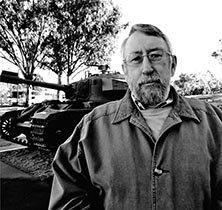Armour in the Australian Army: Is There Something Wrong? Part 4
Share the post "Armour in the Australian Army: Is There Something Wrong? Part 4"

Does it not seem strange that the Australian Army’s most expensive equipment procurement project ever – $15billion worth – is to provide 450 medium tanks to equip four infantry battalions with one per section of 10 men?
FILE PHOTO: Boxer CRV. Photo by Brian Hartigan.
The German Army of the Second World War used the term ‘Panzer-Grenadier’ to describe infantry units that supported tanks.
Very different thinking now drives the British Army’s organisation.
The European battlefield of the future is now seen as one in which rapid advances of more than 100km per day will be commonplace.
The units that travel these distances will be required to engage enemy front-line forces.
It is obviously not feasible for light cavalry to conduct such operations; nor can heavy armoured units be expected to travel as quickly as needed over such distances – ergo, the new ‘strike’ formations.
Here we have infantry integrated with medium armoured vehicles (aka IFVs).
These will be units that can break free from traditional ‘heavy’ and ‘light’ constraints – units that can travel quickly across country and deliver a powerful punch (even deal with the enemy’s ‘heavy’ elements) when they arrive.
The British Army intends to procure 800 of these AFVs (referred to over there as MIV – mechanised infantry vehicle), which have much greater mobility than main battle tanks and can almost equal their firepower.
For some time in the UK there has been a distinction between armoured infantry and mechanised infantry.
The latter are essentially infantry as we know them, i.e. transported in APCs with the intention of dismounting before the objective.
Armoured infantry, however, have much-better-protected AFVs to allow them to close with the objective itself.
An enormous amount of effort has gone into developing tactics for armoured infantry.
The Australian Army is about to purchase 450 IFVs to equip four armoured infantry battalions.
But these are to be used to operate in conjunction with MBTs, not seize the initiative in operations separate to them.
Are the design specifications for LAND 400 Phase 3 therefore appropriate?
Does the Australian Army really require a $30m IFV to equip each section in four battalions?
If these vehicles are justified on the basis of their ability to conduct independent operations, is not the RAAC the best qualified to conduct mobile warfare?
.
READ MORE ON THIS TOPIC: HERE
.
.

Bruce Cameron served in the Australian Army for 19 years, commanded the last troop of tanks in action in Vietnam and attend the UK’s Long Armour Infantry Course and Royal Military College of Science, as well as the Australian Command and Staff College. In his last appointment, Bruce contributed to developing the Army’s future ground mobility requirements. He left the Army in 1987 for the Office of Defence Production. Now retired, Bruce lives in Canberra with wife Jasmine. He published a book – Canister! On! Fire! Australian tank operations in Vietnam – in 2012.
.
.
.
.
.
.
.
.

.
.
Share the post "Armour in the Australian Army: Is There Something Wrong? Part 4"






Fred,
Rather than play the man in respect of your comments to Bruce, how about you put something forward on the same topic? Your views might be accurate in relation to him, but it just comes across as petty to slag someone off without putting up your own work for review in my humble opinion. Food for thought, mate.
Regards.
For those who may be confused, the above comment is directed at another comment since deleted, because it attacked the author, not the argument (see my comment below).
Brian Hartigan
CONTACT Editor
The author’s opinion in these articles are just that – the personal opinion of someone (with some expertise or knowledge of the subject). If you have a counter opinion, feel free to express that here in the comments section, or write your own ‘blog’, which we’ll happily consider publishing too.
Feel free to agree or disagree with any author’s opinions expressed via CONTACT – but you must keep it civil and non-personal – attack the opinion or idea, not the man.
Brian Hartigan
CONTACT Editor